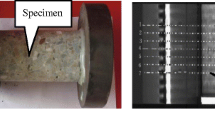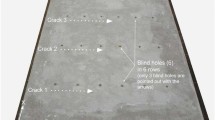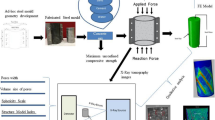Abstract
Microcracks inside concrete have close relations with the mechanical properties and the durability of concrete. The purpose of this study is to investigate the relationship between the mechanical properties of damaged concrete and the cracks with the width of several micro meter. This study proposes a quantitative evaluation method for damage of concrete through the crack observation using a microscope. In this proposed method, the density of cracks is evaluated based on the number of cracks and the traverse length in a similar way with the linear traverse method for the air-void system. Several damaged concrete specimens were prepared with uniaxial cyclic compression loading. The compressive stress ratios and the number of loading cycles were varied as the experimental parameters. The experimental results showed that the number of cracks increased with the increase of the compressive stress ratios and the number of loading cycles. The increase of micro cracks showed good agreement with the decrease of ultrasonic pulse velocity. In addition, the density of cracks have a direct correlation with the modulus of static elasticity, the consumed energy, and the residual strain of the damaged concrete. Finally, this study suggests a possibility to estimate the mechanical properties of the damaged concrete through the crack observation.
Access provided by CONRICYT-eBooks. Download conference paper PDF
Similar content being viewed by others
Keywords
- Damage evaluation
- Stress and strain curve
- Modulus of static elasticity
- Consumed energy
- Ultrasonic pulse velocity
1 Introduction
Technologies that accurately evaluate the condition of concrete structures and predict their future performance are required for the maintenance management of concrete structures. Microcracks in concrete are caused by the mechanical and environmental actions during the service life, and are closely related to the process of failure and deterioration of concrete structures.
One of the investigation method of microcracks is direct assessment such as a microscopic observation (e.g. M. Elzafraney and P. Soroushian 2004) and X-ray (e.g. Y. Obara et al. 2016). Several previous researches suggested that it is possible to evaluate and predict the mechanical properties or the durability of concrete by evaluating microcracks. Saichi et al. (2001) reported that the number of cracks in concrete induced by the loading is a stochastic variable that conforms to the Poisson distribution. T. Matsumura et al. (2003) proposed a frost damage evaluation method and deterioration progress prediction method based on the crack observation.
In addition, surface strain measurements is also one of the damage evaluation method. K. Onoue and H. Matsushita (2012) explained the reduction in compressive strength of concrete due to permeation of liquid based on the deformation and energy absorption properties of the concrete specimens. M. Thiele et al. (2016) showed the strain distribution at specimen surface taken by digital picture correlation. If it is assumed that the occurrence and progression of microcracks caused by external forces are part of the energy transformation process in concrete, it is very likely that microcracks in concrete and the deformation properties of concrete are actually related.
This study focused on the cracks with the width of several micro meter, and proposes a quantitative evaluation method for damage of concrete through the crack observation. Several damaged concrete cylinders were prepared with uniaxial cyclic compression loading. This study investigated the relationship between the mechanical properties such as the stress and strain curve, the modulus of static elasticity, and the consumed energy of damaged concrete and the cracks through the crack observation.
2 Materials and Specimens
The specimens of this study were concrete cylinders of 100 mm diameter and 200 mm height. The mix proportion of the specimens and the properties of the fresh concrete are listed in Table 1. Ordinary Portland cement, natural sand, and crushed stone with maximum particle size of 20 mm were used. Air-entraining and water-reducing agent were also mixed as the admixture. This mix proportion provided the air content of 6.2% with the slump of 20.5 cm. The specimens were sealed and cured in a thermostatic chamber at 20 °C until the time of testing at ages of 216 to 272 days.
In this study, the concrete cylinders which were damaged by uniaxial cyclic compression loading were prepared as the specimens. The test cases are summarized in Table 2. The compressive stress ratios and the number of load cycles were varied as the experimental parameters. Three compressive stress ratios of cyclic loadings were 35%, 65%, and 85% of the average compressive strength of three cylinder specimens. This average compressive strength was 38.3 MPa. The cyclic loads were applied once, 5 times, 10 times, and 20 times at the three stress ratios. S000 specimen was the unloaded specimen. S100 specimen was loaded to failure without cyclic loading. S85-39 specimen with target of 40 cyclic loadings failed when the cyclic loads of 39 times were applied.
The loadings of all specimens were conducted with a universal testing machine of 5000 kN capacity. The loading and unloading speed were 0.6 MPa/s in all specimens. During loadings, the compressive strains were measured by two strain gages with 60 mm attached on the opposite side of specimens. After the cyclic loading, to measure the modulus of static elasticity of the specimens damaged by cyclic loadings, one more loading was carried out at the compressive stress of 35%. And furthermore, before and after loading, the ultrasonic pulse velocities were also measured in the direction perpendicular to loading.
In this study, to investigate the relationship between cracks in the concrete and consumed energy, the area under the stress-strain curves was multiplied by the specimen volume to calculate each energy. The strain energy applied to the specimen by external force is converted to the elastic strain energy and to the consumed energy and their relationship is shown in Eq. (1).
where E t is the total strain energy (N·m), E r is the elastic strain energy (N·m), and E i is the consumed energy (N·m).
3 Microcrack Observation
After loadings, the specimens were cut in the direction perpendicular to loading using a concrete cutter (Fig. 1(a)). The sections exposed in this manner were used as the surfaces of the crack observation. The individual surfaces were grinded with abrasives to obtain smooth plane surfaces. The series of abrasives were #80, #320, and #800. After grinding, the ultrasonic cleaner was used to clean the observation surfaces. After that, the observation surfaces were coated with a fluorescent paint.
The crack observation and crack density calculations were performed based on the method proposed by Matsumura et al. (2003). When the cracks were observed, the ultraviolet lamp was used to irradiate the observation surface so that any fluorescent paint remaining in the cracks would be visible. The length of traverse and the area based on the maximum size of aggregate according to the linear traverse method (ASTM C457/C457M-12) was applied. In this study, the traverse lines with the intervals of 3 mm were set (Fig. 1(b)). A microscope equipped with a camera having an on-screen magnification of approximately 240 times was used to count the number of cracks crossing the traverse lines (Fig. 1(c)).
The crack density in each specimen was calculated using Eq. (2). In this equation, the number of cracks obtained from the observations and the length of traverse were considered.
where C n is the crack density (cracks/mm), N is the total number of cracks crossing the traverse line, and L is the length of traverse (mm).
4 Mechanical Properties of Damaged Concrete
Figure 2 shows the stress-strain curves of S35-20, S65-20, and S85-39 specimens. As the cyclic loading progressed, the residual strain and the strain at the upper applied load increased. The increase in the strains of the specimens with higher stress ratio were greater than that of the specimens with lower stress ratio. Many researchers reported that the stress and strain curve of the specimens subjected to cyclic compressive stresses gradually changed from a convex upward curve to a straight line and finally changes to a curve that is convex downward. In this study, the higher the stress ratio, the more visible of this tendency was observed.
Figure 3(a) shows the changes of the elastic modulus ratio for the first loading of the specimens. In the stress ratio of 35%, the modulus of static elasticity did not change significantly. However, in the stress ratio of 65%, the modulus of static elasticity declined by approximately 10% at the first loading cycle, and then it remained almost constant. In the stress ratio of 85%, the modulus of static elasticity declined sharply during early loading cycles and then tended to decline gradually as the number of loading cycles increased. The change of this modulus of static elasticity is presumed to be caused by the occurrence and progression of cracks in concrete according to the stress ratio and number of loading cycles. Figure 3(b) shows the change of consumed energy. In the specimen with the stress ratio of 35%, the consumed energy was insignificant, and no change was observed during cyclic loading. On the other hand, the specimens with the stress ratio of 65% or 85% showed a significant consumed energy at the first loading cycle and afterward, a tendency to converge. However, S85-39 specimen that failed under cyclic loading with the stress ratio of 85% showed a slight increase of consumed energy from at the 30th loading cycle.
5 Relationship Between the Mechanical Properties and the Microcracks
In all specimens, it was possible to observe cracks with widths between a few micrometers and 1/10 mm (Fig. 4). In the specimens with higher stress ratio, the cracks had progressed and widened in the paste and around their aggregate interfaces. The results of the crack observations are summarized in Table 3. Even though S000 specimen were not loaded, the cracks were observed.
Figures 5(a) and (b) show the relationship of the residual strain and the total consumed energy with the crack density. The residual strain increased with the high crack density. The total consumed energy tended to increase when the crack density is greater than approximately 0.2 cracks/mm. These suggest that as the degree of damage increased, the occurrence and progression of microcracks were accompanied by the increase of energy consumed.
Figure 6(a) shows the relationship of the ultrasonic pulse velocity ratio with the crack density at location of the crack observation in all specimens. The higher the crack density, the greater the decline of the ultrasonic propagation velocity ratio. There is a good correlation of crack density, which directly evaluates the degree of damage to the concrete, with the ultrasonic propagation velocity. Figure 6(b) shows the relationship of the elastic modulus ratio with the crack density. It can be seen that the higher the crack density, the more the modulus of static elasticity declines. The occurrence and progression of the microcracks inside the concrete greatly affect the modulus of static elasticity of the concrete.
The above test results show that it is possible to estimate the mechanical properties of damaged concrete based on the crack density obtained by observing microcracks. However, to accurately predict and evaluate the mechanical properties and durability of damaged concrete by evaluating the microcracks, it is necessary to clarify the effect of length, width, distribution of cracks for the further study.
6 Conclusions
This study investigated the relationship between microcracks and mechanical properties of concrete damaged by cyclic loading. The study obtained the following results.
-
(1)
The stress and strain curve of the specimens subjected to cyclic compressive stresses gradually changed. The modulus of static elasticity of concrete decrease with the higher the stress ratio and the more the loading cycles.
-
(2)
It was possible to observe cracks with widths between a few micrometers and 1/10 mm by using the proposed observation method.
-
(3)
The study confirmed a correlation between crack density, which directly indicates the degree of concrete damage, and ultrasonic wave propagation velocity.
-
(4)
The crack density obtained by microcrack observation correlated with the modulus of static elasticity ratio, total consumed energy, and residual strain of concrete subjected to cyclic loading.
-
(5)
The study showed that it is possible to estimate the mechanical properties of damaged concrete by directly evaluating the condition of concrete through crack observation.
References
ASTM: Standard Test Method for Microscopical Determination of Parameters of the Air-Void, C457/C457M–12 (2012)
Onouea, K., Matsushita, H.: Reduction mechanisms of static compressive strength in concrete due to permeation of liquids. Constr. Build. Mater. 35, 808–816 (2012)
Elzafraney, M., Soroushian, P.: Assessment of microcrack development in concrete materials of different strengths. Mater. Struct. 37(10), 724–731 (2004)
Saichi, M., Sinoue, H., Mihashi, H.: Distribution property of the internal cracks in concrete damaged by the external forces. Concr. Res. Technol. 12(1), 75–87 (2001). (in Japanese)
Thiele, M., Petryna, Y., Rogge, A., Baeßler, M.: Experimental investigation of fatigue process in concrete under high-cycle loading. In: Proceedings of fib symposium 2016, 027 (2016)
Matsumura, T., Katsura, O., Yoshino, T.: Properties of frost damaged concrete and the estimation of the degree of frost damage. J. Struct. Constr. Eng. 563, 9–13 (2003). (in Japanese)
Obara, Y., Tanikura, I., Jung, J., Shintani, R., Watanabe, S.: Evaluation of micro-damage of concrete specimens under cyclic uniaxial loading by X-ray CT method. J. Adv. Concr. Technol. 14(8), 433–443 (2016)
Author information
Authors and Affiliations
Corresponding author
Editor information
Editors and Affiliations
Rights and permissions
Copyright information
© 2018 Springer International Publishing AG
About this paper
Cite this paper
Nakamura, T., Taniguchi, M. (2018). Damage Evaluation of Concrete Under Cyclic Loading by Crack Observation. In: Hordijk, D., Luković, M. (eds) High Tech Concrete: Where Technology and Engineering Meet. Springer, Cham. https://doi.org/10.1007/978-3-319-59471-2_105
Download citation
DOI: https://doi.org/10.1007/978-3-319-59471-2_105
Published:
Publisher Name: Springer, Cham
Print ISBN: 978-3-319-59470-5
Online ISBN: 978-3-319-59471-2
eBook Packages: EngineeringEngineering (R0)










